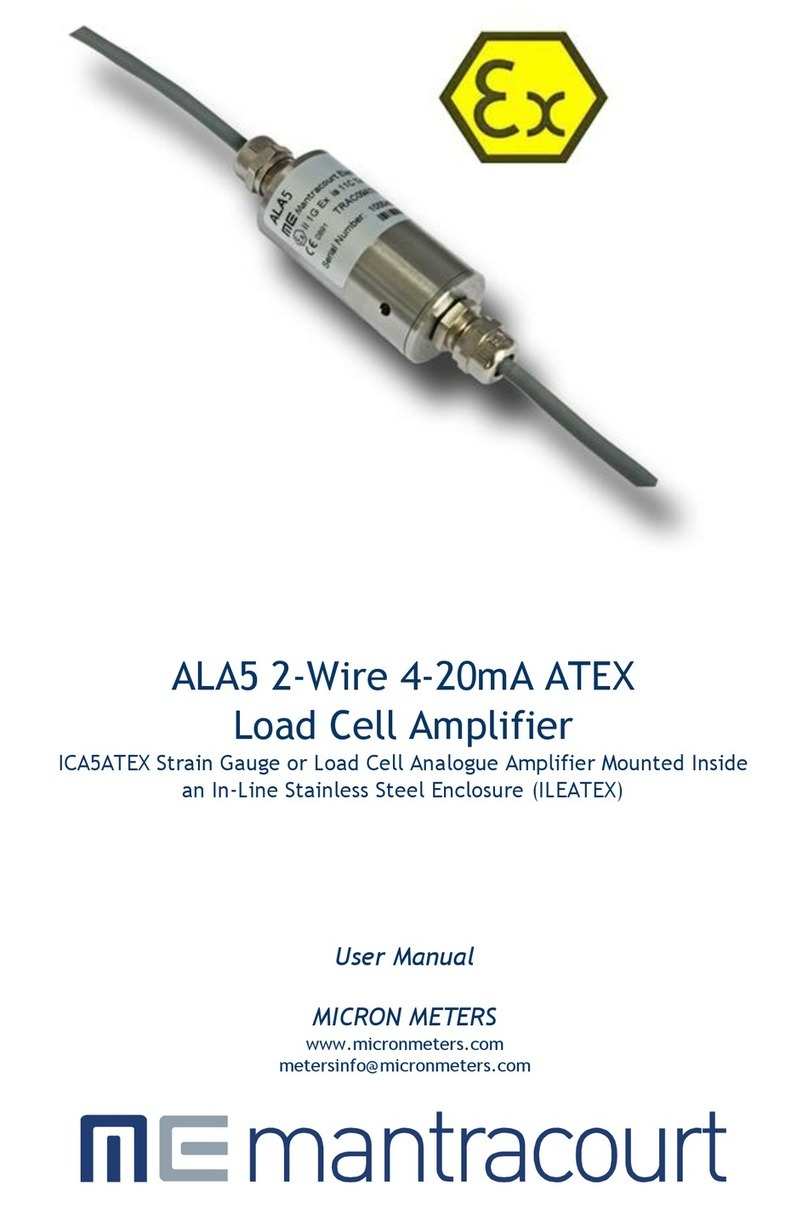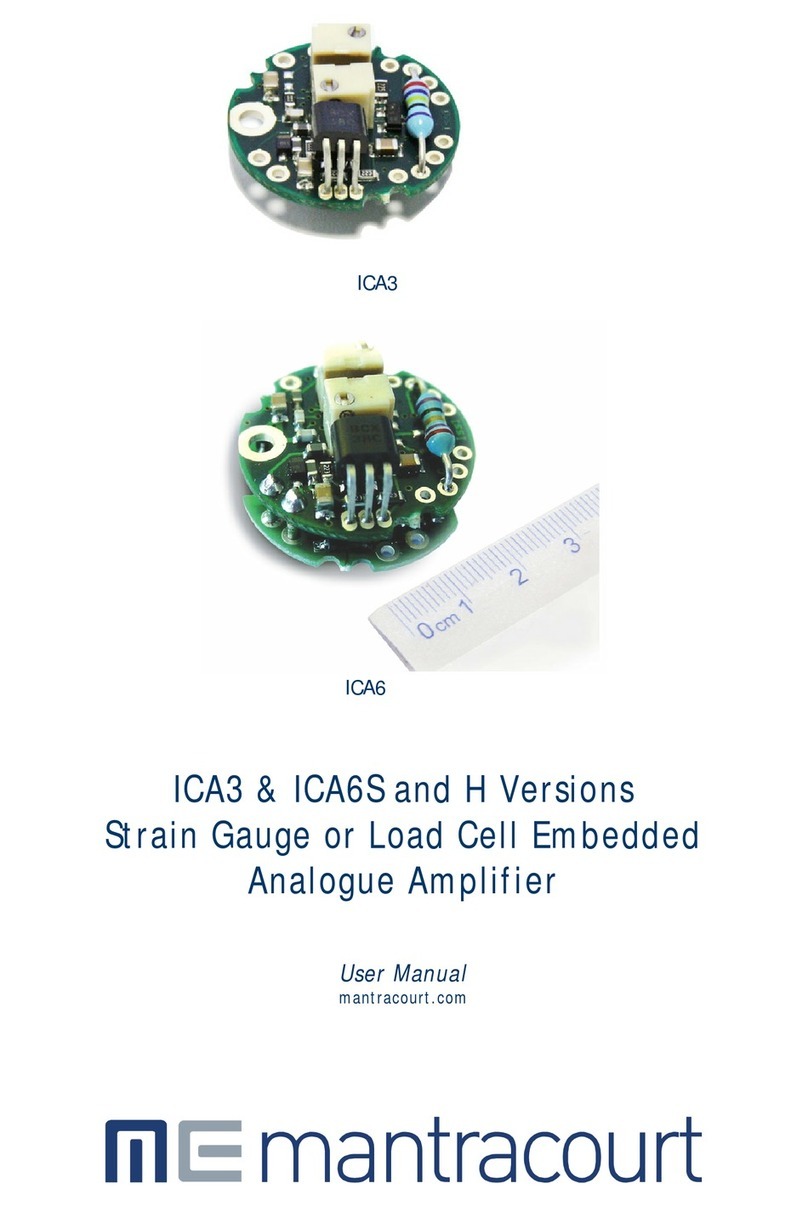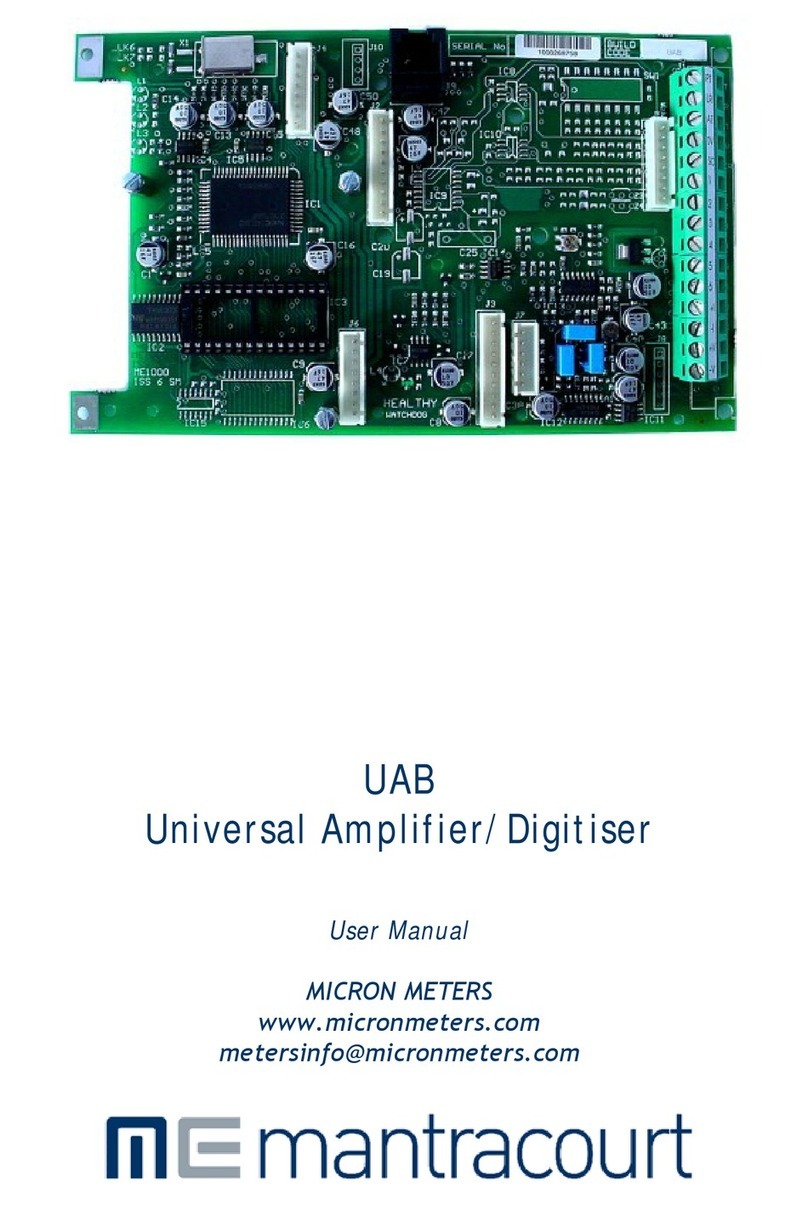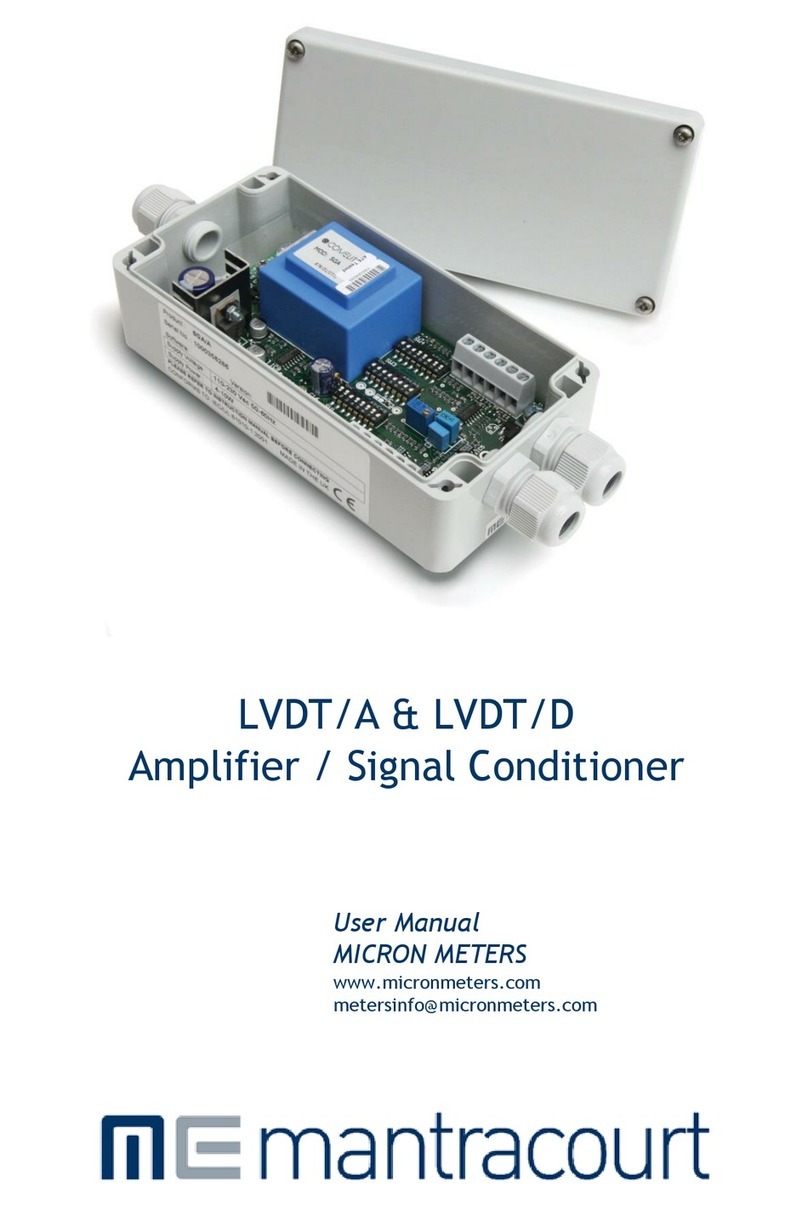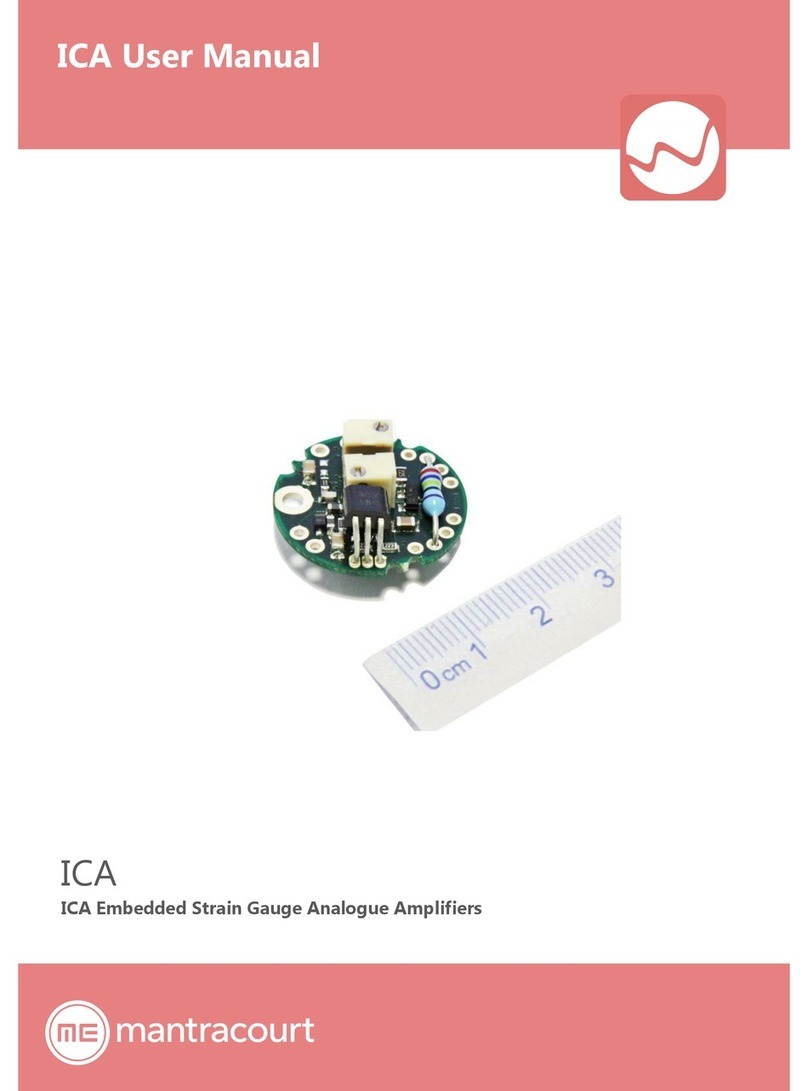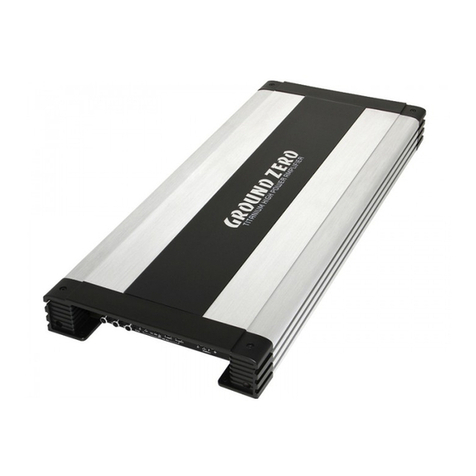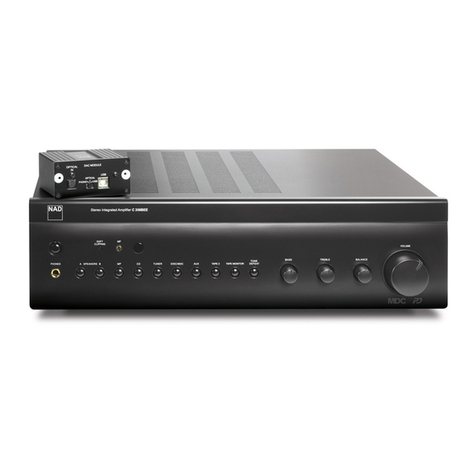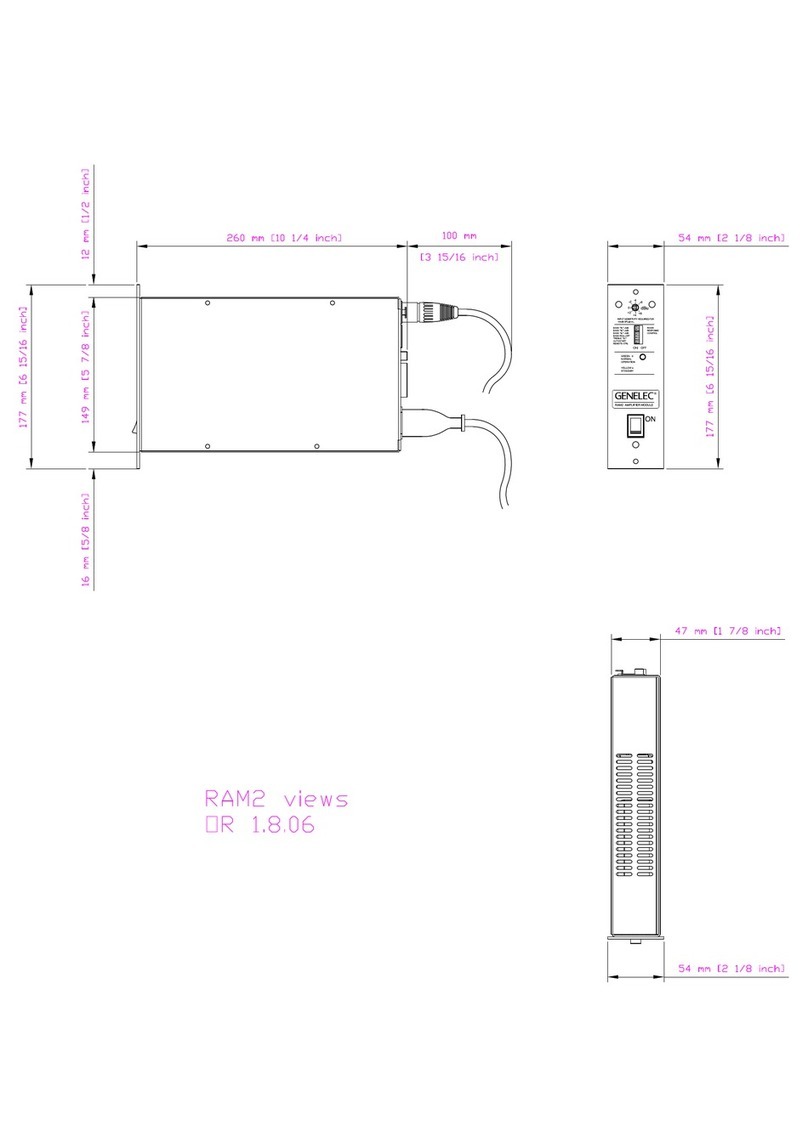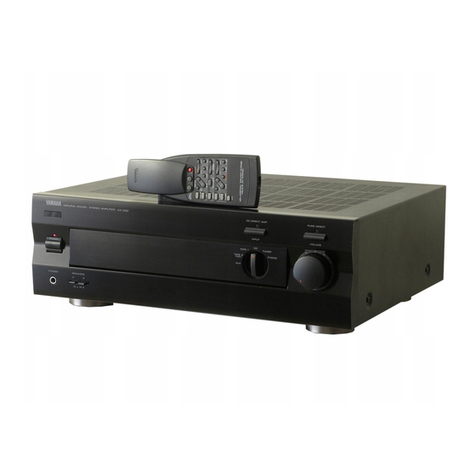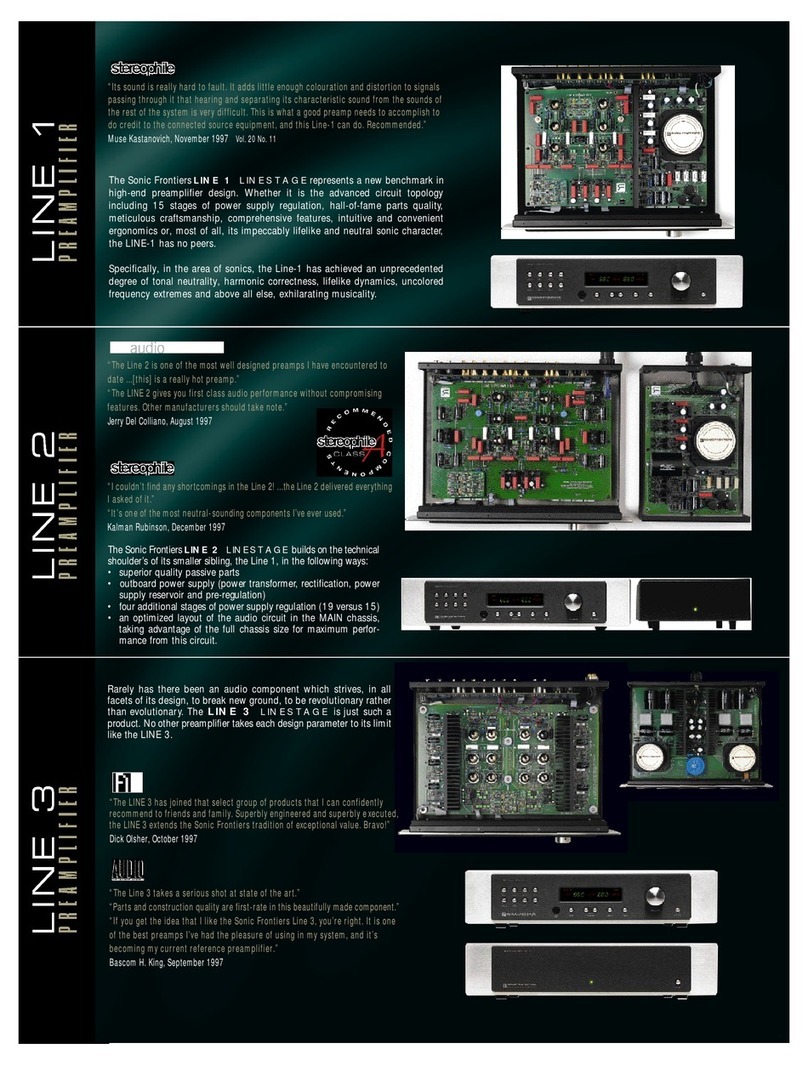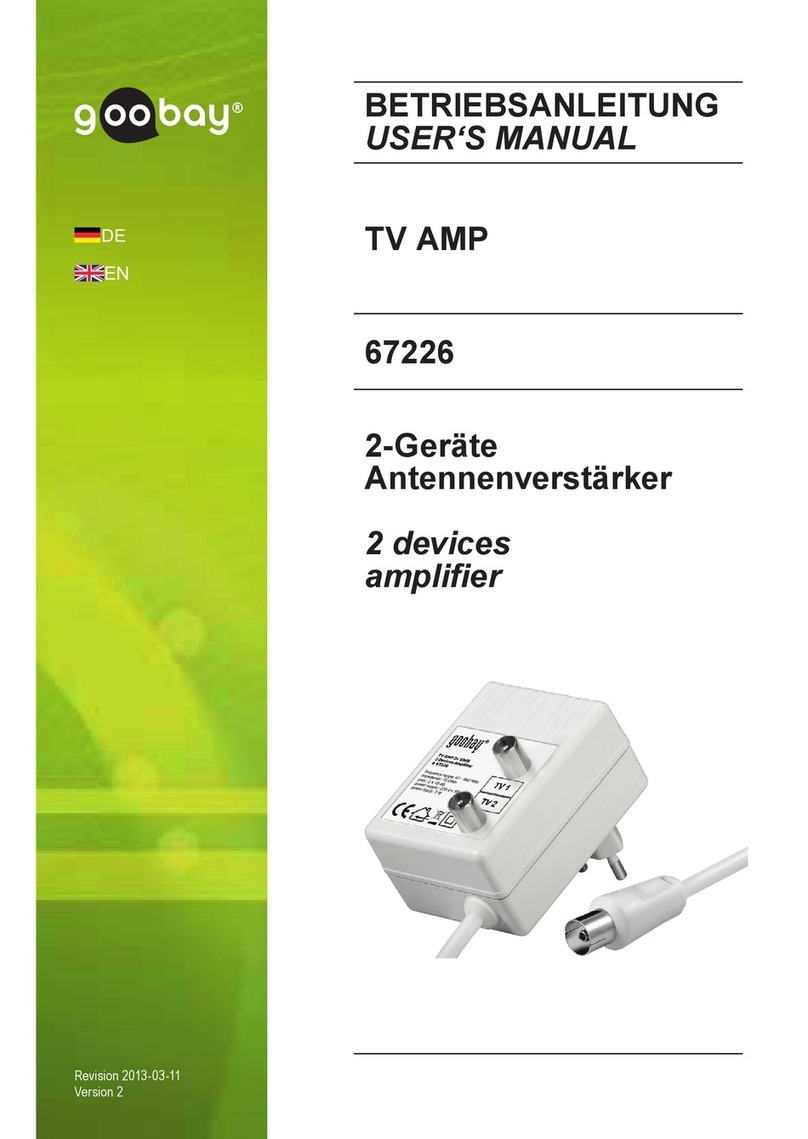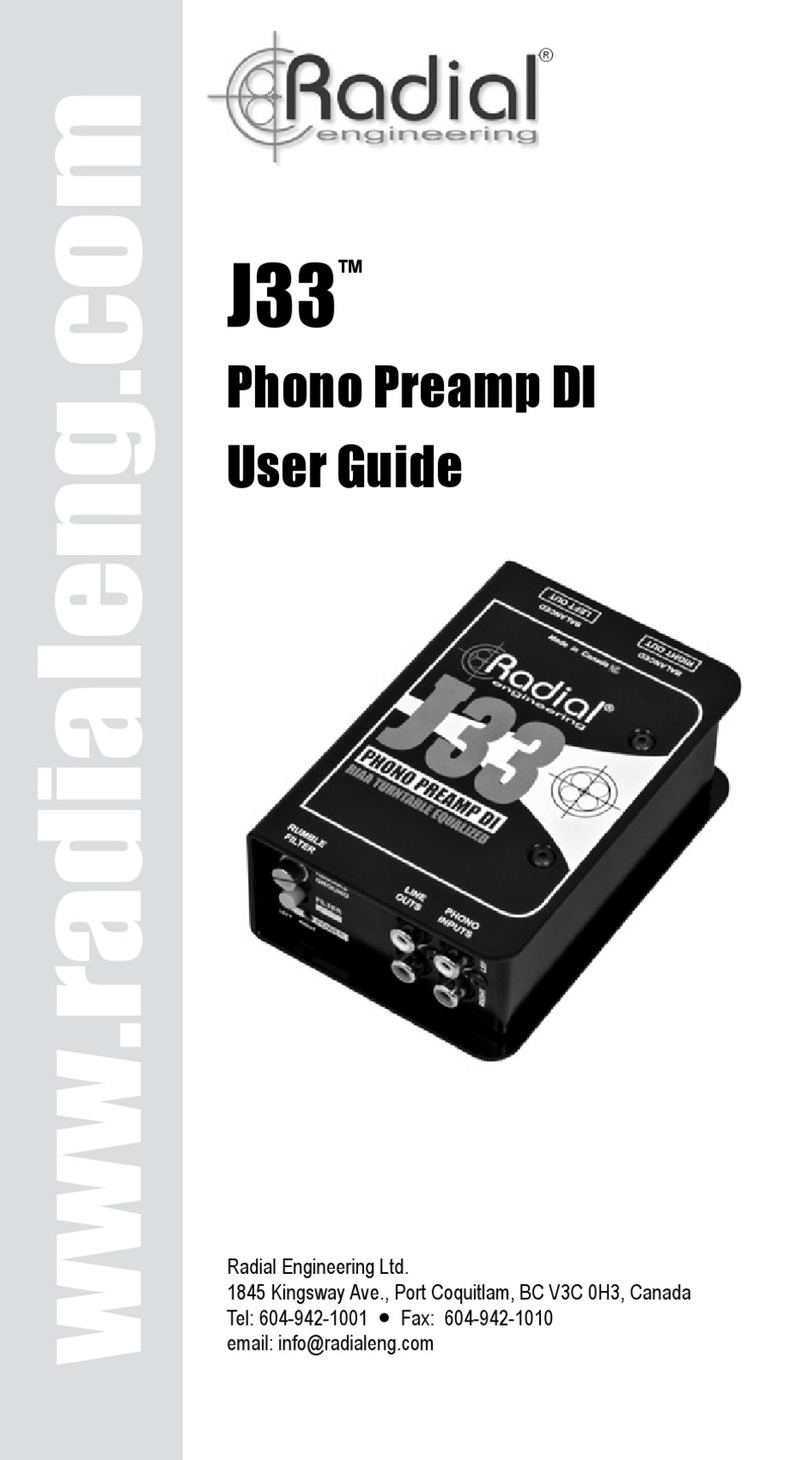Mantracourt SGA/A User manual

SGA/A & SGA/D
Strain Gauge / Load Cell Amplifier /
Signal Conditioner
Issue 7 PCB onwards
User Manual
www.mantracourt.co.u

Mantracourt Electronics Limited SGA/A & SGA/D User Manual
1
SGA/A & SGA/D Manual
Contents
Chapter 1 Introduction to SGA/A & SGA/D ......................................................................................... 2
The Strain Gauge Amplifier SGA ....................................................................................................... 2
Figure 1.1 SGA Signal Conditioner ..................................................................................................... 2
Chapter 2 Installing the SGA/A & SGA/D ............................................................................................ 3
Pre Installation............................................................................................................................ 3
Figure 2.1 Dimensions ................................................................................................................... 3
Cabling...................................................................................................................................... 4
Power Connection ........................................................................................................................ 4
Figure 2.2 Power Connection ........................................................................................................... 4
Figure 2.3 Input (Sensor) Connections ................................................................................................ 5
Table 2.1 ................................................................................................................................... 5
Output Connections ...................................................................................................................... 6
Figure 2.4 Output Connections ......................................................................................................... 6
Chapter 3 Switch Settings ............................................................................................................. 7
Figure 3.1 Output Settings–Switch 4................................................................................................... 7
Table 3.1 Output Option ................................................................................................................ 7
Table 3.2 Switch 4........................................................................................................................ 7
Table 3.3 ................................................................................................................................... 8
Output Filter Settings –Switch 3........................................................................................................ 8
Table 3.4 Switch 3........................................................................................................................ 8
Table 3.5 ................................................................................................................................... 9
Output Current Mode and Input Filter Settings – Jumpers JP1, JP2 & JP3 ..................................................... 9
Figure 3.2 .................................................................................................................................. 9
Span (Gain) Setting Switch SW1 ....................................................................................................... 10
Table 3.6 – SW1 .......................................................................................................................... 10
Table 3.7 .................................................................................................................................. 11
Shunt Calibration Switch SW1/8 ...................................................................................................... 11
Table 3.8 .................................................................................................................................. 11
Figure 3.3 ................................................................................................................................. 11
Zero (Offset) Setting Switch SW2 ..................................................................................................... 11
Table 3.9 .................................................................................................................................. 12
Table 3.10................................................................................................................................. 12
Chapter Calibration ..................................................................................................................13
Output ..................................................................................................................................... 13
Zero Offset................................................................................................................................ 13
Sensitivity ................................................................................................................................. 13
Figure 4.1 Calibration Connections using Millivolt Source........................................................................ 15
Chapter 5 Troubleshooting ...........................................................................................................16
Chapter 6 Product Care ...............................................................................................................18
Chapter 7 Glossary .....................................................................................................................19
Chapter 8 Specifications for SGA/A & SGA/D Load Cell Amplifiers...........................................................22
CE Approvals.............................................................................................................................. 23
Warranty .................................................................................................................................. 23
Figure 8.1 Connection Details ......................................................................................................... 24
Other Mantracourt Products..........................................................................................................25

Mantracourt Electronics Limited SGA/A & SGA/D User Manual
2
Chapter 1 Introduction to SGA/A & SGA/D
The Strain Gauge Amplifier SGA
The SGA is a Strain Gauge Amplifier, converting a strain gauge input to a Voltage or current output – otherwise
nown as a Signal conditioner.
The SGA provides a wide range of signal conditioning for Strain gauges, Load cells, Pressure and Torque transducers.
igure 1.1 SGA Signal Conditioner
POWER
SUPPLY
STRAIN
GAUGE
AMPLIFIER
OUTPUT
±10V
±5V
0-5V
0-20mA
4-20mA
Inputs
L ad Cells
Strain Gauges
T rque Transducers
Pressure Transducers
110/230 V AC
18-24V DC
INPUT
Offered in two versions, the SGA/A for 110/230V AC or 18-24V DC operation and the SGA/D which is DC powered
only.
Transducer SENSITIVITY of between 0.1 mV/V and 30 mV/V are possible.
This is achieved by a combination of gain (span) DIP switches and associated fine adjustment by a potentiometer.
Similarly transducer zero OFFSET and SCALE DEAD BAND of up to 79% can be compensated for in the module.
This is achieved again by a combination of zero DIP switches and associated fine adjustment by a potentiometer.
The module has built-in FILTERS to cancel the field effects of vibration, agitation and electrically noisy
environment.
The on-board low pass filter can be switched in and adjusted (from 1Hz to 5 Hz) using a series of DIP switches.
A wide range of proportional output options for currents and voltages can be configured by DIP switch settings.
Both the AC and DC versions are based on a common board and are mounted in an IP65 (NEMA 4X) ABS case.

Mantracourt Electronics Limited SGA/A & SGA/D User Manual
3
Chapter 2 Installing the SGA/A & SGA/D
Pre Installation
See Specification details in Chapter 8 for details of Environmental Approvals.
Carefully remove the SGA/A unit from its pac ing. Chec that the unit is complete and undamaged.
The SGA/A & SGA/D units can operated in any industrial environment providing the following limits are not
exceeded
Operating Temperature -10 ºC to +50 ºC
Humidity 95% non condensing
Storage temperature -10 ºC to +50 ºC
While the unit is sealed to IP65 (NEMA 4X) it is advisable to follow the following installation practice where possible
• Minimise vibration.
• Do not mount next to strong electrical fields (transformers, power cables)
• Ensure easy access to interior of the module
• Install electrical protection device, as the unit is not internally fused.
• Always ensure the lid is properly fitted and all 4 screws tightened.
• Always ensure the cable gland is sealing against the cable to maintain the IP (NEMA) rating.
igure 2.1 Dimensions
148mm (5 ”)160mm (6 ”)
All w f r cable entry
at either end
Depth
55mm(2.16”)
80mm 50mm
(1 ”) M unting H les
15
16
5
16
7
8
(3⅛”)
The 4 screws for the lid are captive and must be tightened to maintain the seal.
The 4.5mm (0.18”) holes for the mounting screws in the base are directly behind the screws for the lid.
The box must not be drilled as this would invalidate the IP rating
Allow sufficient space at both sides for the cable entry.
The Nylon 66 cable glands are designed for ROUND cables.
The waterproof entry and strain relief will seal to a higher rating than the enclosure.
Cable diameter should be between 4mm (0.16”) and 7mm (0.27”)

Mantracourt Electronics Limited SGA/A & SGA/D User Manual
4
Cabling
Power Connection
Two power supply options are available
SGA/A: 220/230VAC, 50/60Hz
110/120VAC, 50/60Hz
5W Max.
SGA/A & SGA/D: 18-24V DC, 5W (approx. 150mA fully loaded)
NOTE: The SGA/A can be powered from AC or DC sources whichever is available
It is also possible to connect BOTH AC and DC simultaneously for security of power
supply
igure 2.2 Power Connection
220-230 V AC
J 3
N
110 - 120 V AC
N
L L
J 3
18 -24 V DC
J 1
+
-
Standard mains 2 or 3 core cable PVC sheathed (unshielded) cable will suffice for the power.
NOTE: Connect the appropriate power to the SGA For AC powering observe the correct
transformer jumper connections as shown in Figure 2 2 above
(This diagram is also provided inside the lid)
Connections to the SGA/A & SGA/D input/output signal and the power supply are made via 2.5mm² field terminal
connectors.
Cable entry in the cased versions is via glands in the ends of the case.

Mantracourt Electronics Limited SGA/A & SGA/D User Manual
5
igure 2.3 Input (Sensor) Connections
NOTE: Strain Excite is the Excitation to the transducer.
Strain Input is the Signal from the transducer.
The Ref 5V/2.5V is generated internally and used for calibration
The cable connecting the sensor to the SGA should be shielded.
This typical cable data is provided for information only.
The cable should have 2 x twin twisted cables. Ideally with each pair individually shielded and with an overall
shield.
Table 2.1
Country Supplier Part No Description
UK Farnell 148-539 Individually shielded twisted multipair cable (7/0.25mm)- 2 pair
Tinned copper drain. Individually shielded in polyester tape.
Diameter: 4.19 mm
Impedance: 54 Ohms: Capacitance/m: core to core 115 pF & core to
shield 203 pF
UK Farnell 585-646 Individually shielded twisted multipair cable (7/0.25mm)- 3 pair
Tinned copper drain. Individually shielded in polyester tape.
Diameter: 6.86 mm
Impedance: 62 Ohms: Capacitance/m: core to core 98 pF & core to
shield 180 pF
UK RS 367-533 Braided shielded twisted multipair cable (7/0.2mm)- 1 pair
Miniature- twin -round Diameter: 4.8 mm
Impedance: 62 Ohms: Capacitance/m: core to core 120 pF & core to
shield 210 pF
If possible segregate the signal cable from Power Cables; allow a 1meter (3 feet) distance from such cables.
Do not run signal cables parallel to power cables. Cross such cables at right angles.
The ground connection conductor should have sufficient cross-sectional area to ensure a low impedance path to
attenuate RF interference.

Mantracourt Electronics Limited SGA/A & SGA/D User Manual
6
Output Connections
Two analogue outputs are available from the SGA, proportional DC current and DC voltage.
The ranges available are as follows: -
Output Range
DC voltage ±10V
±5V
NB: Maximum Load on voltage ranges is 2mA.
0 - 10V
0 - 5V
DC current 0 - 20mA NB: Maximum impedance 500R.
4 - 20mA
The DC current support both ‘sin ’ and ‘source’ modes of operation.
Two jumpers JP1 & JP2 provide the means of selecting the desired mode.
igure 2.4 Output Connections
In ‘Sink’ mode the +ve end of the load is connected to the internal +15V supply on the SGA and the -ve end is
connected to the SGA output. The current through the load is ‘sun ’ by the SGA towards ground (0V).
N.B. In this mode neither connection to the output load is electrically common to the load cell.
Select this option by fitting the two jumpers, JP1 and JP2 to the ‘outside’ positions (See Figure 3.2)
In ‘Source’ mode the +ve end of the load is connected to the SGA output and the current is ‘sourced’ by the SGA
output through the load towards ground (0V).
This mode has the advantage that the negative output connection is common to the load cell
‘- Excitation’ terminal.
Select this option by fitting the two jumpers, JP1 and JP2 to the ‘inside’ positions (See Figure 3.2)
See Chapter 3 for switch settings and details of SINK & SOURCE jumpers.

Mantracourt Electronics Limited SGA/A & SGA/D User Manual
7
Chapter 3 Switch Settings
Switch Positions
e.g. The switches in Figure 3.1 are depicted as ALL ON.
igure 3.1 Output Settings–Switch 4
Use switch 4 to select the required output and, if
required, the low pass filter and 5V Excitation.
(See Tables 3.1 and 3.2)
Table 3.1 Output Option
Input Range -20mA 0 - 20mA -20mA 0 - 20mA 0 - 10V 0 - 5V ±10V ±5V
+ Full Scale 20mA 20mA 20mA 20mA 10V 5V 10V 5V
↑ ↑ ↑ ↑ ↑ ↑ ↑ ↑ ↑
0 4mA 0mA 12mA 10mA 5V 2.5V 0V 0V
↓ ↓ ↓ ↓ ↓ ↓ ↓
- Full Scale n/a n/a 4mA Note 1 0mA Note 1 0V 0V -10V -5V
N.B. Full scale output on the voltage ranges is achieved with a bi-polar (±) input
Note 1 Negative inputs can be accommodated on the current output ranges by setting the ‘Zero’ switch SW2 to
+50% (Table 3.8) and setting SW1 to twice the required mV/V setting (Table 3.6).
Table 3.2 Switch 4
Analogue Output and Excitation Voltage Options - SW
SW 1 2 3 5 6 7 8
±10V 0↓ 0↓ 0↓ X X 1↑=Filter in 1↑Filter out 1↑=10V Exc 0↓=5V Exc
±5V 0↓ 1↑ 0↓ X X 1↑=Filter in 1↑Filter out 1↑=10V Exc 0↓=5V Exc
0-10V 0↓ 1↑ 1↑ X X 1↑=Filter in 1↑Filter out 1↑=10V Exc 0↓=5V Exc
0-5V 1↑ 1↑ 1↑ X X 1↑=Filter in 1↑Filter out 1↑=10V Exc 0↓=5V Exc
0-20mA X X X 0↓ 0↓ 1↑=Filter in 1↑Filter out 1↑=10V Exc 0↓=5V Exc
-20mA X X X 1↑ 1↑ 1↑=Filter in 1↑Filter out 1↑=10V Exc 0↓=5V Exc
Filter out X X X X X 0↓ 1↑ 1↑=10V Exc 0↓=5V Exc
Filter in X X X X X 1↑ 0↓ 1↑=10V Exc 0↓=5V Exc
10V Exc X X X X X 1↑=Filter in 1↑Filter out 1↑
5V Exc X X X X X 1↑=Filter in 1↑Filter out 0↓
Switch settings (0 = Off 1 = On X = Don’t Care)
Important: Low pass filtering is switched into operation by setting SW4/6 ‘ON’↑ and SW4/7 ‘OFF’↓.
Reverse these settings to bypass the filter.
It should be noted that either one of these switches MUST be on but not BOTH
O
utput Option

Mantracourt Electronics Limited SGA/A & SGA/D User Manual
8
Example :- 0-10 Volt output with no filter required.
Table 3.3
SW 1 2 3 4 5 6 7 8
0-10V 0
↓
1
↑
1
↑
X X 0
↓
1
↑
X
SW
tsrrsssrst
Output ilter Settings –Switch 3
The SGA incorporates a second order (-12dB/oct) low pass filter which can be switched in to improve the
performance and output signal quality in electrically noisy environments.
It can also be used to reduce the effects of high frequency fluctuations in the load or applied force to the load cell.
The cut off frequency of the filter is set by the DIP switch SW3 as illustrated in the table below
Table 3.4 Switch 3
SW3 1 2 3 5 6 7 8
1Hz 0
↓
0
↓
0
↓
0
↓
0
↓
0
↓
1
↑
1
↑
5Hz 1
↑
0
↓
0
↓
0
↓
0
↓
1
↑
1
↑
1
↑
10Hz 1
↑
1
↑
0
↓
0
↓
1
↑
1
↑
1
↑
1
↑
50Hz 1
↑
1
↑
1
↑
1
↑
1
↑
1
↑
1
↑
1
↑
100Hz 0
↓
0
↓
0
↓
0
↓
0
↓
0
↓
0
↓
0
↓
500Hz 1
↑
0
↓
0
↓
0
↓
0
↓
1
↑
0
↓
0
↓
800Hz see note**
1kHz 1
↑
1
↑
0
↓
0
↓
1
↑
1
↑
0
↓
0
↓
5kHz 1
↑
1
↑
1
↑
1
↑
1
↑
1
↑
0
↓
0
↓
** Note:
A SECONDARY low pass filter, with a cut off frequency of 800Hz, can be switched into the SGA input by fitting a
link to JP3 (see Figure 3 2)
Important: Low pass filtering is switched into operation by setting SW4/6 ‘ON’↑ and
SW4/7 ‘OFF’↓. Reverse these settings to bypass the filter.
It should be noted that either one of these switches MUST be on but not BOTH

Mantracourt Electronics Limited SGA/A & SGA/D User Manual
9
Example :-
The Switch Settings for a cut-off frequency of 50 Hz setting is illustrated below.
Note: SW4/6 must be ‘ON’ and SW4/7 must be ‘OFF’
Table 3.5
SW3 1
2
3
4
5
6
7
8
50Hz 1
↑
1
↑
1
↑
1
↑
1
↑
1
↑
1
↑
1
↑
SW3
trrrrrrrrt
Output Current Mode and Input ilter Settings – Jumpers JP1, JP2 & JP3
igure 3.2
Refer to Figure 2.4 for details of wiring connections to J1.

Mantracourt Electronics Limited SGA/A & SGA/D User Manual
10
Span (Gain) Setting Switch SW1
Ranges 1 to 60 – from 0.06 mV/V to 30.30 mV/V
↑ = ON (1) ↓ = OFF (0). SW1/8 switches on the shunt cal function – see Table 3.8
Table 3.6 – SW1
27.10 mV/V
57
1 2 3 4 5 6 7 8
x
28.30 mV/V
23.10 mV/V
15.60 mV/V
5.72 mV/V
4.89 mV/V
4.05 mV/V
3.72 mV/V
2.95 mV/V
2.35 mV/V
1.49 mV/V
0.80 mV/V
0.65 mV/V
0.50 mV/V
0.31 mV/V
0.11 mV/V
29.30 mV/V
24.60 mV/V
17.80 mV/V
7.50 mV/V
5.12 mV/V
4.26 mV/V
3.73 mV/V
3.19 mV/V
2.49 mV/V
1.78 mV/V
0.91 mV/V
0.70 mV/V
0.55 mV/V
0.34 mV/V
0.17 mV/V
30.30 mV/V
25.90 mV/V
19.70 mV/V
10.50 mV/V
5.34 mV/V
4.36 mV/V
4.00 mV/V
3.35 mV/V
2.63 mV/V
1.99 mV/V
1.20 mV/V
0.75 mV/V
0.60 mV/V
0.39 mV/V
0.23 mV/V
58
54
50
46
42
38
34
30
26
22
18
14
10
6
2
59
55
51
47
43
39
35
31
27
23
19
15
11
7
3
60
56
52
48
44
40
36
32
28
24
20
16
12
8
4
1
1
1
1
1
1
1
1
1
1
1
1
1
1
1
1
1
1
1
1
1
1
1
1
1
1
1
1
1
1
1
1
1
1
1
1
1
1
1
1
1
1
1
1
1
2
2
2
2
2
2
2
2
2
2
2
2
2
2
2
2
2
2
2
2
2
2
2
2
2
2
2
2
2
2
2
2
2
2
2
2
2
2
2
2
2
2
2
2
2
3
3
3
3
3
3
3
3
3
3
3
3
3
3
3
3
3
3
3
3
3
3
3
3
3
3
3
3
3
3
3
3
3
3
3
3
3
3
3
3
3
3
3
3
3
4
4
4
4
4
4
4
4
4
4
4
4
4
4
4
4
4
4
4
4
4
4
4
4
4
4
4
4
4
4
4
4
4
4
4
4
4
4
4
4
4
4
4
4
4
5
5
5
5
5
5
5
5
5
5
5
5
5
5
5
5
5
5
5
5
5
5
5
5
5
5
5
5
5
5
5
5
5
5
5
5
5
5
5
5
5
5
5
5
5
6
6
6
6
6
6
6
6
6
6
6
6
6
6
6
6
6
6
6
6
6
6
6
6
6
6
6
6
6
6
6
6
6
6
6
6
6
6
6
6
6
6
6
6
6
7
7
7
7
7
7
7
7
7
7
7
7
7
7
7
7
7
7
7
7
7
7
7
7
7
7
7
7
7
7
7
7
7
7
7
7
7
7
7
7
7
7
7
7
7
8
8
8
8
8
8
8
8
8
8
8
8
8
8
8
8
8
8
8
8
8
8
8
8
8
8
8
8
8
8
8
8
8
8
8
8
8
8
8
8
8
8
8
8
8
x
x
x
x
x
x
x
x
x
x
x
x
x
x
x
x
x
x
x
x
x
x
x
x
x
x
x
x
x
x
x
x
x
x
x
x
x
x
x
x
x
x
x
x
x
21.50 mV/V
53
1 2 3 4 5 6 7 8
x
49
45
41
37
33
29
25
21
17
13
9
5
1
13.20 mV/V
5.54 mV/V
4.63 mV/V
4.00 mV/V
3.46 mV/V
2.91 mV/V
2.07 mV/V
1.41 mV/V
0.75 mV/V
0.61 mV/V
0.44 mV/V
0.28 mV/V
0.06 mV/V
1
1
1
1
1
1
1
1
1
1
1
1
1
2
2
2
2
2
2
2
2
2
2
2
2
2
3
3
3
3
3
3
3
3
3
3
3
3
3
4
4
4
4
4
4
4
4
4
4
4
4
4
5
5
5
5
5
5
5
5
5
5
5
5
5
6
6
6
6
6
6
6
6
6
6
6
6
6
7
7
7
7
7
7
7
7
7
7
7
7
7
8
8
8
8
8
8
8
8
8
8
8
8
8
x
x
x
x
x
x
x
x
x
x
x
x
x
Please Note:
When using 5V Excitation (SW4 switch 8 = OFF), divide the transducer's mV/V output by two and set SW1 to the
nearest setting shown in table 3.6 above
e.g. for 2.5mV/V with 5V excitation choose the 1.2mV/V setting

Mantracourt Electronics Limited SGA/A & SGA/D User Manual
11
Example :-
A strain gauge has a sensitivity of 2.809 mV /V - Select Switch Setting number 28 from Table 3.6 and fine tune with
potentiometer PI
Table 3.7
SW1 1
2
3
5
6
7
8
2.63 mV/V 0
↓
1
↑
1
↑
0
↓
0
↓
0
↓
0
↓
X
SW1
tsrrssssst
Refer to Chapter 4 for calibration details.
Shunt Calibration Switch SW1/8
SW1/8 connects a 120 50ppm surface mount resistor across the ‘+Excitation’ and ‘+ Input’ terminals of the SGA.
This shunts one arm of the connected load cell to produce a nown change in output which can be used for
calibration or chec ing the integrity of the load cell and associated wiring.
Table 3.8
SW1 1 2 3 5 6 7 8
Shunt Cal ON x x x x
x x
x
1
↑
Shunt Cal OFF x x x x x x x 0
↓
The 120 resistor can be ta en out of circuit and replaced by a user defined leaded component by carefully cutting
the fine lin as shown in Figure 3.3. Use the right hand pad and either of the left hand pads to fit the new
component.
The surface mount resistor can be reinstated by re-connecting the two pads either side of the cut lin .
igure 3.3
Zero (Offset) Setting Switch SW2
This offset can be used to compensate for the transducer zero error, to tare the scale dead load or to shift the
output.
These settings allow the user to calibrate a zero offset. The range allows for up to 79% of the span.
Potentiometer P2 provides fine adjustment.

Mantracourt Electronics Limited SGA/A & SGA/D User Manual
12
Table 3.9
SW2 1 2 3 5 6 7 8
% + ve Offset - ve Offset 40% 20% 10% 5%
2%
1%
Example :-
An installation has a tare of 15 g with a 200 g strain gauge which gives an output of 6.37mV/V at 10V excitation.
The tare equates to 7.5% (15/200). Set the switches to nearest % (5 + 2) and fine trim with Potentiometer P2.
The tare must be subtracted therefore the ‘- ve Offset’ switch SW2/2 should be ‘ON’.
The calibrated zero mV reading would be 4.78 mV i.e. 7.5% of 63.7mV
Table 3.10
SW2 1
2
3
5
6
7
8
7.5% 0
↓
1
↑
0
↓
0
↓
0
↓
1
↑
1
↑
0
↓
SW2
tsrsssrrst
Note
SW2 /1 & 2 should never be 'ON ' together. Either one or other should be 'ON ' if an
offset is required; otherwise both switches should be 'OFF '.
Switch settings 3 to 8 are ADDITIVE. The offset value of each switch is added to give
a total offset of 78%.
Fine adjustment is provided by potentiometer P2.

Mantracourt Electronics Limited SGA/A & SGA/D User Manual
13
Chapter 4 Calibration
The SGA/A & SGA/D provides the excitation supply and signal conditioning to cater for a wide range of strain
gauges, load cells, pressure transducers or torque transducers.
Output
Select the analogue output range as detailed in Chapter 3, Figure 3.1,Table 3.1 & 3.2 by means of SW4.
Zero Offset
Select the offset as detailed in Chapter 3, Table 3.9 by means of SW2.
Having selected the polarity and the offset nearest to that required with the switches use the fine potentiometer P2
to achieve the final setting.
Sensitivity
Select the sensitivity as detailed in Chapter 3, Table 3.6 by means of SW1.
Switches 1-4 of SW1 provide fine setting of the SGA sensitivity while switches 5-7 give coarse control.
This arrangement allows the SGA to cover a wide range of strain gauge sensitivities without sacrificing stability and
ease of set up.
Locate the required sensitivity in the table and set switches 1-7 of SW1 accordingly.
Potentiometer P1 provides fine trimming and range overlap to enable the SGA to be calibrated precisely to any
given value within its ranges.
Note 1 If the range is repeated in the table e g 4mV/V (4 0, 4 05 and 4 0 mV/V) choose the
setting which has the greatest number of switches 1-4 set to ‘off’ i e SW1 = [1000]
[000] This will enable finer trimming to the final value using potentiometer PI
The sensitivity settings shown in Table 3.6 assume that the load cell is fully loaded. The sensitivity settings can be
used to maximise the output when the full range of the load cell is not being used. Here are a couple of examples.
Example 1 A 2.5mV/V load cell provides 10V for an l00Ib load. However it is never loaded above
50lb
The sensitivity setting can be set to 1.25 mV/V.
Table 3 6 /20 (1 20mV/V SW1 = [1101][000]
Example 2 When a reduced output is required from a fully loaded transducer, use a less
sensitive switch setting
For an 8 volt output from a fully loaded 2 5mV/V load cell use the 3 19mV/V setting
i e (10/8x2 5=3 125mV/V)
Table 3.6 /31 (1.20mV/V SW1 =[0010][000]

Mantracourt Electronics Limited SGA/A & SGA/D User Manual
14
The SGA/A & SGA/D can be calibrated with the transducer connected, provided that two calibration points can be
implemented. e.g. by applying nown weights or forces. If this is not possible, a stable mV source or load cell
simulator can be used provided that the precise sensitivity (mV/V) and full range output ( g) of the transducer is
nown. In this case the 'Ref (5V/2.5V)' output should be connected to 'Strain Input-' and the mV source applied
between ‘Strain Input+’ and ‘Strain Input-’.
Actual calibration is carried out in the following way:-
1. Set the correct switch settings on SW1 as described above using the transducer's calibration sheet supplied by the
manufacturer. This is normally specified as sensitivity or full range output and should be in mV/V
2. Apply the nown low calibration conditions (weight, force or mV/V: this may be zero if required), and note the
analogue output, having ensured that the SW1 settings are correct for the transducer sensitivity as step 1 above.
3. Apply the nown high calibration conditions (for optimum accuracy this should be at least 75% of full load) and
note the analogue output.
4. Use the fine trim control, P1, to obtain the required change in Volts or mA, between the two calibration points
(steps 2 and 3). e.g. If the required output at the low calibration point is 0V and the required output at the high
calibration point is 7.5V, adjust P1 in step 4 to produce a change of 7.5V between the calibration points.
Initially, the low calibration point may not produce 0V at the output. If this is the case, note the reading, e.g.
0.5V, apply the high calibration conditions and trim P1 for the required change in output. i.e. Trim the output
for 0.5 + 7.5 = 8V.
5. Use the fine ‘Zero’ control, P2 in conjunction with the coarse switches SW2/3-8 and polarity switches SW2/1 and
2 to set the output to the required absolute values. Each switch within SW2 offsets the output by a particular
percentage of full scale as shown in Table 3.9
N.B. It may be necessary to repeat these steps until the required output is achieved.

Mantracourt Electronics Limited SGA/A & SGA/D User Manual
15
igure 4.1 Calibration Connections using Millivolt Source
mV S urce
-+
J2
Strain Input
(Strain Gauge Output)
Ref (5V/2.5V)
Shield (0V)
Strain Excite ( 10V/5V)
Excitati n
-
+
-
+
1. The ‘Ref (5V/2.5V)’ should be connected to ‘Strain Input-’ and the mV source applied between ‘Strain Input+’ &
‘Strain Input-’
2. Set the correct switch settings on SW1 as described above using the transducer's calibration sheet supplied by the
manufacturer. This is normally specified as sensitivity or full range output and should be in mV/V
3. Ensure the Zero and Span switch settings are correct, as detailed in Chapter 3, Tables 3.6 & 3.9
4. Apply the nown low calibration conditions and fine adjust P2.
5. Apply the nown high calibration conditions and fine adjust P1
6. Repeat steps 3 and 4 until the required output is achieved.
Hint If the required output at the low calibration point is 0V and the required output at
the high calibration point is 7 5V, adjust P1 in step 5 to produce a change of 7 5V
between the calibration points Initially, the low calibration point may not produce 0V
at the output If this is the case, note the reading, e g 0 5V, apply the high
calibration conditions and trim P1 for the required change in output, i e Trim the
output for 0 5 + 7 5 = 8V

Mantracourt Electronics Limited SGA/A & SGA/D User Manual
16
Chapter 5 Troubleshooting
1. No output
a) Chec power supply is present (LED is on).
b) Chec the output connections are correct.
c) Chec terminations (ensure insulation is not trapped in terminal, cable brea etc.)
d) Chec the sensor is connected (typically reading 350 Ohm across Strain Excite + and – and also
Strain Input + and – of J2) with the power off.
e) Chec the Excitation voltage (J2) is at 10V DC
1.a For voltage output
a) Chec V out+ and V out- terminals are wired
b) Chec the load is connected and is not open or short circuited
c) Chec SW4 settings are correct for Voltage Output see Chapter 3, Table 3.2
d) Chec Span and Zero settings (SW1 and SW2)
1.b For current output
a) Chec Isin + and Isin - terminals are used for 'Sin ' current output
b) Chec Isource+ and Isource- terminals are used for 'Source' current output.
c) Chec the load is connected and is not open circuit
d) Chec load does not exceed 500 Ohms.
e) In 'Sin ' mode chec 15 V is present at +ve terminal of load.
f) In 'Source' mode chec the -ve terminal of the load is connected to ground.
g) In 'Sin ' mode chec the load is isolated from the load cell (sensor) excitation.
h) In 'Source' mode chec the -ve output is common to the -ve Excitation.
i) Chec output SW 4 settings are correct for current see Chapter 3, Table 3.2
j) Chec Span and Zero settings (SW1 and SW2) see Chapter 3, Table 3.6 & 3.9
2. Low Output
This is when an output is present but not of sufficient magnitude to meet the required value.
b) Chec power supply is within specified limits (i.e. is not low)
c) Chec the sensor is connected (typically reading 350 Ohm across Strain Excite + and – and also
Strain Input + and – of J2) with the power off.
d) Chec the Excitation voltage (J2) is at 10V DC
e) Chec the calibration. Incorrect setting of the calibration Span switches are the most common cause of low
output - particularly when associated with ± Voltage outputs. Refer to the calibration instructions in Chapter 4.
Refer to tutorial on the calibration set-up.
f) Chec the Zero (offset) is correct for the sensor. This too is a common reason for low outputs.
3. High output
This is when an output is present but higher (in span or zero) than required.
b) Chec the sensor is connected (typically reading 350 Ohm across Strain Excite + and – and also
Strain Input + and – of J2) with the power off.
c) Chec the Excitation voltage (J2) is at 10V DC
d) Chec the Zero (offset) is correct for the sensor. This is a common reason for high outputs where the offset is
either omitted or incorrect for the sensor. Refer to the calibration instructions in Chapter 4
e) Refer to tutorial on the calibration set-up
f) Chec the calibration. Incorrect setting of the calibration span switches is the most common cause of high output
- particularly when associated with ± Voltage outputs.

Mantracourt Electronics Limited SGA/A & SGA/D User Manual
17
4. Unstable Output
This is when the output is unstable or varies. The cause could be (a) poor installation or (b) a noisy environment.
Poor Installation -This is when an output is present but higher or lower (in span or zero) than expected:
a) Chec the installation for problems and repair where necessary
b) Poor termination
c) High resistance on cable leads
d) Low insulation impedance
e) Proximity to High Voltage Equipment – Transformers, Contactors, Motors etc.
Noisy Environment-
a) Chec if the source can be found and remove noise
b)
Chec the cable shielding and ensure it is correctly installed and terminated
5. Calibration
This section assumes that the unit is providing an output that is not stuc at top or bottom of the scale.
(See paragraphs 1 to 4 if this is the case)
Ensure you have the calibration set-up correctly installed i.e.mV source and output as required.
Ensure you are connected to the correct sensor and not to another adjacent unit.
Ensure you have the correct calibration data from the sensor manufacturer. This must include a certified table with
offset, zero and linearity.
Ensure the temperature and other environmental parameters are within specification and where necessary ta en
into account when calibrating should such parameters have an effect on the calibration.
6. Fine Span (Gain) and Zero (Offset ) Adjustment Problems
If the adjustment cannot reach the maximum output desired then, chec the tare is not too high.
If the potentiometer does not alter the output the unit must be repaired – remove from service.
It is always wise to chec a nown good SGA against the problem installation before rejecting the suspect SGA.

Mantracourt Electronics Limited SGA/A & SGA/D User Manual
18
Chapter 6 Product Care
A worn out component, excessive use in harsh environments, an overly zealous operator; regrettably some
circumstances necessitate repair.
At Mantracourt Electronics Ltd we can't guarantee that a product will never require repairing. We can, however,
promise a repair service of exceptional quality, one which is governed by a rigorous procedure.
Detailed below is our pledge to you: a defined set of ground rules and procedures to which we will adhere. All we
as in return is that you assist us with our procedure, such that we can maintain our promise to you. Please note
that warranty repairs may not be available on overdue accounts, and that a strict interpretation of our conditions of
trading invalidates warranty claims where late payment has occurred.
Please refer to ‘Customer Repair Service Procedure’ document – contact your supplier for a copy.
In the unli ely event you have problems with the SGA module we would advise that you ta e the following
precautions:-
• The unit is installed as instructed.
• Recommended spares are ept in stoc . We can assist.
• Sufficient expertise available for first line maintenance.
• Routine maintenance chec s are performed – annually is recommended.
• The necessary documentation for the product is available to the maintenance personnel.
We recommend you keep on file – as a minimum
• This Manual
• The settings of the switches and lin s on the SGA card
• The calibration figures for the attached sensors
• The instrument loop to which the output is connected
• A record of the ‘normal’ output – if applicable
• A maintenance record of the SGA
• A contact phone number from the supplier for assistance

Mantracourt Electronics Limited SGA/A & SGA/D User Manual
19
Chapter 7 Glossary
AWG American Wire Gauge.
Bac ground Noise The total noise floor from all sources of interference in a measurement
system, independent of the presence of a data signal. (See noise)
Bipolar The ability of a signal conditioner to display either positive or negative
readings.
Bridge Resistance The resistance measured across the excitation terminals of a strain
gauge.
Calibration The process of adjusting an instrument or compiling a deviation chart so
that it’s reading can be correlated to the actual value being measured.
CMR
(Common-Mode
Rejection)
The ability of an instrument to eliminate the effect of AC or DC noise
between signal and ground. Normally expressed in dB at dc to 60 Hz. One
type of CMR is specified between SIG LO and PWR GND. In differential
meters, a second type of CMR is specified between SIG LO and ANA GND
(METER GND).
Common Mode Rejection
Ratio
The ability of an instrument to reject interference from a common
voltage at its input terminals with relation to ground. Usually expressed
in db (decibels).
Deadband / hysteresis (Hysteresis) In a digital controller, there may be one switching point at
which the signal increases and another switching point at which the signal
decreases. The difference between the two switching points is hysterisis.
Drift A change of a reading or a set point value over long periods due to
several factors including change in ambient temperature, time, and line
voltage.
Dual Power supply The SGA/A can have a Dual Power Supply. An AC supply can be connected
along with a DC supply for additional security.
Excitation The external application of electrical voltage applied to a transducer for
normal operation.
Fine Adjustment The Zero and Span calibration have a Fine Adjustment to give accuracy to
the calibration. These are potentiometers P1 and P2 for span and zero
respectively.
Full Bridge A Wheatstone bridge configuration utilizing four active elements or strain
gauges.
Full Range Output The algebraic difference between the minimum output and maximum
output.
Gain Gain is otherwise identified as SPAN. It relates to the proportional output
to the sensor input. Calibration of the SGA is determined by setting the
Gain (Span) and Offset (Zero).
The amount of amplification used in an electrical circuit.
Ground 1)The electrical neutral line having the same potential as the surrounding
ground. 2) The negative side of power supply. 3) Reference point for an
electrical system.
Input Impedance The resistance measured across the excitation terminals of a transducer.
Linearity The closeness of a calibration curve to a specified straight line. Linearity
is expressed as the maximum deviation of any calibration point on a
specified straight line during any one calibration cycle.
Load The electrical demand of a process expressed as power (watts), current
(amps) or resistance (ohms).
Load Impedance The impedance presented to the output terminals of a transducer by the
associated external circuitry.
Load cell The load cell is one of a series of Strain Gauge sensors that the SGA input
is designed to accept. (Torque Sensor, Pressure & temperature
transducers).
Low Pass Filter
The SGA Module has a low pass filter to remove unwanted signals on the
output. This can be set to suit the installation, from DC to 5 Hz.
This manual suits for next models
1
Table of contents
Other Mantracourt Amplifier manuals

